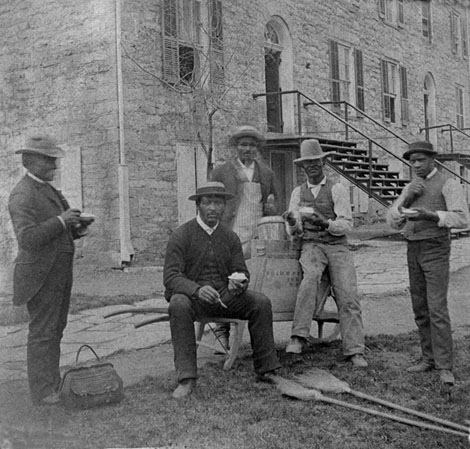
Four Dickinson College Janitors And Noah Pinkney
Outside East College Around the 1880's

Two of the people in the picture can be identified. The man wearing the apron is named Noah Pinkney and the man sitting below him to the left is named Robert Young. The other men can not be identified except for the fact that it is assumed that they are George Norris, Sr., George Norris, Jr., and Sam Watts. The four men mentioned were janitors in 1873. It is possible, but very unlikely, that these men were the janitors from 1870 who were "Judge" Watts, Sam Watts, Andrew Beal, George Norris, and Robert Young, however "Judge Watts" retired in 1871 and he does not seem to resemble anyone in a Dickinson College yearbook where the janitors are pictured. Evidence leads to the conclusion that these janitors are the same as in the 1873 group even though only one janitor can be positively identified as Robert Young. Robert Young was the janitor in charge of the First Section of East College.
The second man who can be certainly identified was known to generations
of young Dickinsonians. Although Noah Pinkney was not a member of
the Dickinson College list of employees, he had a tremendous impact on
the college. Noah, known as "Pink" or "Uncle Noah", was born in Frederick
County, Maryland on December 31, 1846. He was born a slave, but after
the Civil War and with Lincoln's Emancipation Proclamation, he was free.
In 1863, he came to Harrisburg and enlisted in the Union Army, in 1864.
He served under General Butler and was present at Appomattox Court House
in April 1865 when General Lee surrendered. Shortly after, he sailed
on a transport from Fortress Monroe, Virginia to Brad's Island, Texas.
He was then discharged and he made his way back to Harrisburg where he
lived for nearly 20 years. In 1884 he moved to Carlisle and made himself
a legend by 1885.
"Pink" sold pretzels, sandwiches, ice cream, cakes, and pies for
nineteen years just outside of the East College gate. On cold winter
days he could be found under the steps of East College, but on the coldest
of days he would sell his treats from his three room house on West Street.
He enjoyed catering to the Dickinson community and the students enjoyed
his treats. Students would listen for his common line of "Fine as
silk, sah. Dickinson sand witches, fine as silk." "Pink" was told in 1894
that he was forbidden to sell his treats on campus, but the students went
out to find him anyway, as quoted in the May, 1895 issue of the Dickinsonian,
"Once more is heard, the old, familiar cry, 'Let's go to Pinkney's'".
Pink died at his home on North West Street on August 6, 1923 at the age
of 77. He had suffered from a sickness that lasted several months
after a slight stroke.(2)
"Pink" remains a legend for the College and around 1952 a plaque
was hung on the East College gate on the side facing the campus.
It reads:
|
NEAR THE EAST COLLEGE GATE WHERE FOR MORE THAN FORTY YEARS NOAH PINKNEY, FORMER SLAVE AND CHRISTIAN GENTLEMAN, SOLD PRETZELS AND GAVE LAVISHLY OF HIS FRIENDSHIP... AS MUCH A PART OF THE COLLEGE AS THE MERMAID OF OLD WEST. HE PASSED OVER JORDAN AT THE AGE OF 77 ON AUGUST 6, 1923, AND THE TRUMPETS SOUNDED ON THE OTHER SIDE. |
Elizabeth McGuiness
Editor's note: At the Convocation of Dickinson's academic year in
September 1999, the new class of 2003 marched together through the East
College Gate both to honor the memory of Noah Pinkney and symbolize
the College's historical relationship with the wider Carlisle community.
John Osborne, October 1999
1). Sellers, Charles
Coleman. Dickinson College: A History. Middletown, CT: Wesleyan
Univ. Press, 1973, p. 581-2.
2). Drop File on
Noah Pinkney, May Morris Room, Dickinson College Archives.